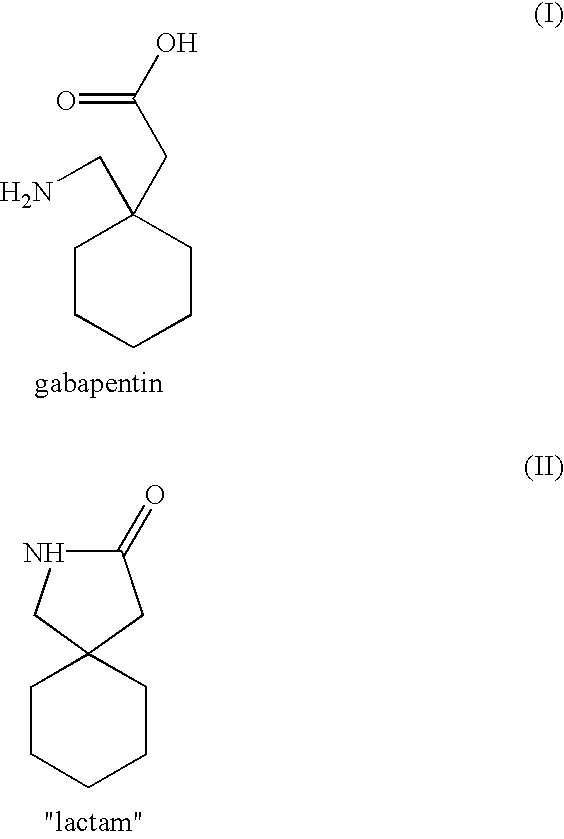Process for the production of 1-(aminomethyl)-cyclohexyl-acetic acid in pure form
a technology of cyclohexyl acetic acid and process, which is applied in the field of process for the production of 1(aminomethyl)cyclohexyl acetic acid in pure form, can solve the problems of large volume and large amount of ion exchange resin, and can not be used on an industrial scal
- Summary
- Abstract
- Description
- Claims
- Application Information
AI Technical Summary
Problems solved by technology
Method used
Image
Examples
example 2
Digestion of gabapentin hydrochloride in acetone
Part of the three crops of gabapentin hydrochloride obtained in Example 1 is loaded in a 1000 ml reactor: first wet crop 140 g.ident.116.7 g (0.539 mols); second wet crop 40 g.ident.31.8 g (0.147 mols); third wet crop 15 g.ident.13.0 g (0.060 mols). Acetone (485 ml) is added to the mixture, which is stirred at 40.degree..div.45.degree. C. for an hour, then slowly cooled to room temperature, then further cooled to 10.degree. C., keeping this temperature for an hour. The residue is filtered, washing the residue with acetone (2.times.30 ml).
Wet product: 162.5 g. The product is dried at 50.degree. C. under vacuum overnight, to obtain 158.8 g of dry product. (Analysis--HPLC: 99.70%; 0.21% ("lactam"); chemical titre HClO4: 95.8%; KF: 4.4%)
Yield: 98.2%.
example 3
Crude gabapentin
Gabapentin hydrochloride hemihydrate (400 g--1.841 mols (Analysis-HPLC: 99.68%; 0.24% ("lactam"); KF: 4.4%; chemical titre: 95.6%) and water (940 ml) are loaded into a 2000 ml glass reactor. The mixture is stirred with heating; the product already dissolves at a temperature of about 23.degree. C. pH is adjusted to 7.1-7.2 by addition of a 30% sodium hydroxide solution (252.1 g) drop by drop. The slightly turbid solution is added with diatomaceous earth (3 g) and stirred for an hour at 60.degree. C. pH is checked and adjusted to constant value of 7.1-7.2 with a 30% sodium hydroxide solution, if needed. The mixture is filtered while hot through fluted filter paper to obtain a clear solution, which is cooled to 15.degree. C., keeping said temperature for an hour. The precipitate is filtered and washed with a water (100 ml)--ethanol (233 ml) mixture cooled to -10.degree. C.
Wet product: 272.4 g. The product is dried at 50.degree. C. under atmospheric pressure for 15 hours...
example 4
Crystallized gabapentin base
85.0 g (0.483 mols) of crude gabapentin (Analysis--HPLC: 99.85%; 0.022 ("lactam"); chemical titre AgNO3: 1.00% (as NaCl); chemical titre HClO4: 97.3%; KF: 1.7%), and deionized water (255 g) are loaded into a 500 ml glass reactor. Most product dissolves upon heating to 75.degree. C., thereby obtaining a slightly turbid solution which is filtered while hot through fluted filter paper and left to crystallize. Precipitation of the product begins at a temperature of about 52.degree. C. The product is left to crystallize overnight, then the mixture is cooled to 0.degree..+-.+5.degree. C. keeping said temperature for 1 hour. The mixture is then filtered under vacuum, washing the residue with a cold mixture of deionized water (17 ml)--ethanol (33 ml). The residue is dried in a static dryer under atmospheric pressure at 50.degree. C. overnight.
Dry product: 55.0 g
(Analysis--HPLC: 99.93%; 0.07% ("lactam"); chemical titre AgNO3 0.025% (as NaCl), KF 0.08%, chemical ti...
PUM
| Property | Measurement | Unit |
|---|---|---|
| temperature | aaaaa | aaaaa |
| temperature | aaaaa | aaaaa |
| temperature | aaaaa | aaaaa |
Abstract
Description
Claims
Application Information
 Login to View More
Login to View More - R&D
- Intellectual Property
- Life Sciences
- Materials
- Tech Scout
- Unparalleled Data Quality
- Higher Quality Content
- 60% Fewer Hallucinations
Browse by: Latest US Patents, China's latest patents, Technical Efficacy Thesaurus, Application Domain, Technology Topic, Popular Technical Reports.
© 2025 PatSnap. All rights reserved.Legal|Privacy policy|Modern Slavery Act Transparency Statement|Sitemap|About US| Contact US: help@patsnap.com

